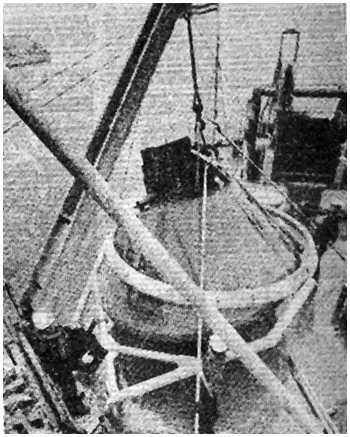BM3 Ron Smith – Photos
Seamen Poised for Apollo Recovery
by JOC JIM FALK – S&S Staff Writer

BM2 Mike Shreeves (at the controls) and crewmen on the destroyer Mansfield practice their jobs for Apollo space capsule recovery during an in port period in Yokosuka this week. (S&S)
YOKOSUKA, Japan – There is a group of U.S. Navymen here ready and raring for the first manned Apollo moon shot to blast off from Cape Kennedy.
They are members of Task Force 130 (CTF-130) – representatives of the Hawaii-based Manned Spacecraft Recovery Force, Pacific.
And just as ready will be the crewmen of eight Western Pacific-based destroyers, as well as the pararescue airmen of the 36th Aerospace Rescue and Recovery Sq. at Tachikawa.
The three units from two services will man one of several stations around the world in a combined effort to rescue the astronauts and recover the capsule should it plunge down in the area.
The CTF-130 representatives, who also serve as logistic representatives for the Navy’s cruiser-destroyer force in the Western Pacific, coordinate the joint rescue effort.
According to Lt. Paul E. Greene, operations officer for the unit, they had two years of experience in the Gemini project before moving into the Apollo field in October 1966.
But to keep on them on their toes, and to give destroyer crews a chance to review rescue procedures, the unit sets training schedules in conjunction with the Air Force rescue squadron’s quarterly training requirement.
“We can’t plan too far ahead on what ships may be available to us from the 7th Fleet,” Greene said. “So we have all eight destroyers, homeported in Yokosuka, rigged to take easily installed cranes for capsule recovery.”
He said they can depend on at least two ships being available when the time comes.
One of the destroyers may be the USS Mansfield, which this week is going through some refresher steps in port and at sea with one of three realistic training capsules maintained by CTF-130 at Yokosuka.
Commander Jack R. Griffin, Mansfield’s skipper, says very little about space capsule rescue and recovery differs from normal shipboard work, but the exercises are good for breaking in new crewmen.
His executive officer, LCDR Robert W. Kesteloot, said maneuvering into position for a recovery is the same ordinary ship handling faced everyday.
Even the crane that picks up the three-man space vehicle is standard equipment, said BM2 Mike Shreeves, who works the controls to pluck the capsule from the water.
Some of the ship’s old-timers have been on board through the transition from Gemini to Apollo.
Lt.(jg) John Tortorici, Mansfield’s combat information center officer, was with the ship when it was on station for the last Gemini shot in September 1966.
“We were off Okinawa and could hear the whole show through a communication hookup with the coordination center in Houston, Texas. the capsule came down on target in the Atlantic, but were ready if it had missed and came down in our area.” he said.
During that shot, Tortorici said, Navy frogmen were on board, ready to go in the water to help the astronauts out of the capsule. That job has since been taken over by Air Force pararescue experts.
Task FOrce 130 representative Greene said these airmen bail out of their HC-130 Hercules with life rafts and flotation gear while the ship stands 100 yards away.
The joint task force has not had a chance to respond to a real manned Apollo shot yet. “We were all set for that shot in January of 1967, which was aborted because of the capsule fire which killed three astronauts, and we’ll be ready for the next one.” Greene said.
[ Photo Locker ]



